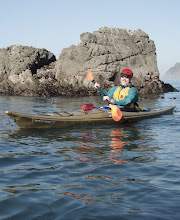
If you knew Cody, you wouldn't call him bright, brave, or very trainable. But you'd love him.
Cody was always up for an adventure, be it a walk around the block, a hike up a mountain, or a moving trip across the country. Whatever it was, it was a joy. And whatever he encountered -- as long as it wasn't something as scary as a mailbox that had been knocked over or as dangerous as the UPS man -- was to be explored until the next scent or movement caught his attention. In most of the pictures we have of him, he's looking away from the camera, his doggie attention deficit disorder preventing him from focusing on whomever held the camera. In those pictures, as in life, his mouth was usually open in the curious, disarming smile.
He was always thrilled to meet another dog and more than happy to be playful and submissive. With new people, he was shy at first, but then warmed up. When Kim went to the vet's to pick him up after he got neutered, she found him playing with the assistants. Talk about not holding a grudge!
Squirrels and a float on the water were the only things that could hold his attention. He could stare up a tree for a quarter hour after the squirrel was long gone. He would cry for you to throw the float, even if he was bordering on exhaustion -- and he was always sure to bring it back.
We got Cody as a puppy 13 1/2 years ago. He was in a kennel with 6 or 7 siblings. He was the one that didn't rush to the kennel gate. Kim said that was the one she wanted, and that was the one we took home.
A little over two years ago, Cody was diagnosed with cancer on his foot, in his spleen, and in his liver. The good doctors at the Oregon State Vet Hospital excised the mass on his foot, removed his spleen, and took out one lobe of his liver. They gave him chemo treatments as followup. The prognosis was a year at most. Last year about this time, another large tumor showed up in his liver. He was given another chemo treatment and nearly died of scepticemia. But he pulled through again. The dog who was afraid of a broken mailbox proved himself to be tough enough to surprise us all.
After the first cancer diagnosis, he went through quite a few health crises, and with each one we prepared to face the loss we knew would come sooner rather than later. But every time he rallied back to smile and wag at the prospect of a new adventure.
I could go on about the all the things Cody did -- stealing bagels and English muffins on the counter, etc., etc. -- but none of that would really get at why he was so special. So I'll just sum it up by saying that everyone who knew him recognized that he was a special dog who saw the world as good and made them see the world the same way.
Two weeks ago, he hit another health crisis and we knew it would be a matter of days. With the help of our vet, he managed one last rally and made it on vacation to the beach one last time. Before the end of the vacation, though, we knew he was at the end of his last rally. Monday our vet made a house call. He greeted her with a smile and a wag before settling down and going to sleep for the final time.



